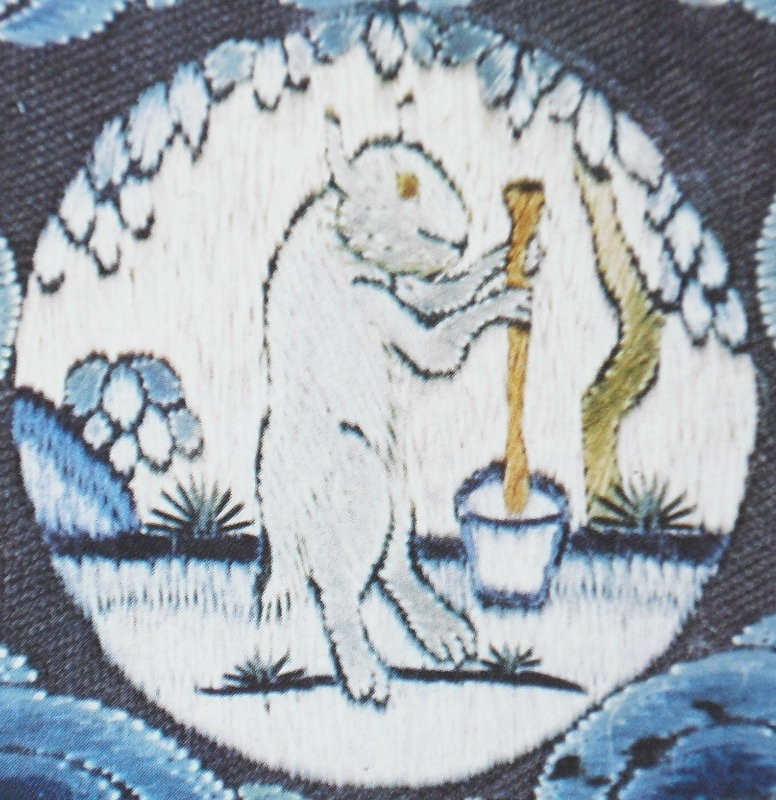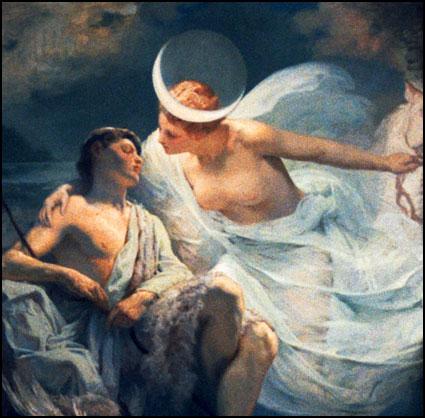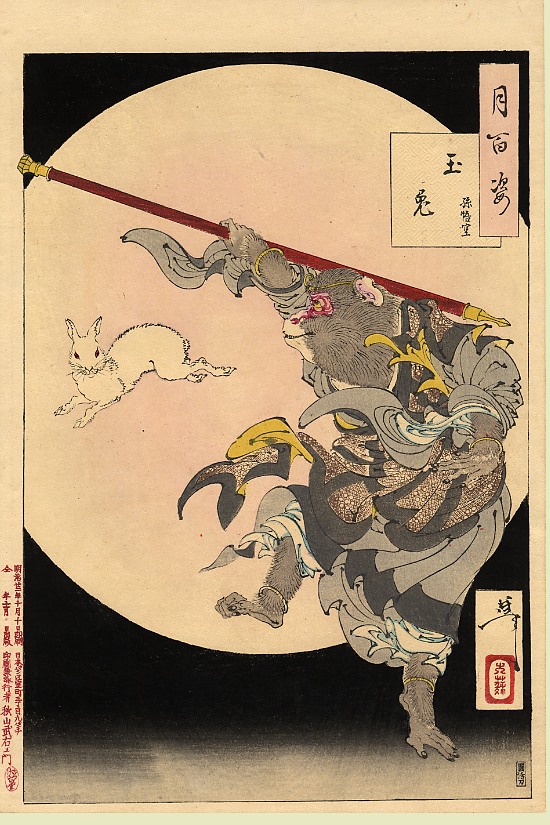|
Tu'er Ye
Tu'er Ye (), also known as the Rabbit God, is a deity of Chinese folk religion unique to Beijing, where his sculptures are traditionally crafted. He is related with moon worship, as he is considered the moon rabbit of the goddess Chang'e. A frequent misnomer is "Tuye Er" (, "Rabbit God (as a) Youth"). Based on the correct Beijing dialect, it should be "Tu'er Ye" (). In his traditional iconography, he rides a tiger, a dragon or a horse, but he is represented standing alone as well. The cult of the Rabbit God started in Beijing in 1906, later in the 20th century disappeared, and was resumed only in the late 2000s. He has a female counterpart, Tu'er Nainai ({{zh, c=兔兒奶奶, p=Tù'ernǎinai, l=Lady Leveret). However the two could be one and the same deity since in some legends, Tu'er Ye changed his appearance depending on what human clothing was donated to him by the people he helped. So Tu'er Nainai could simply be a cross-dressing Tu'er Ye. He is not to be confused with T ... [...More Info...] [...Related Items...] OR: [Wikipedia] [Google] [Baidu] |
Deity
A deity or god is a supernatural being considered to be sacred and worthy of worship due to having authority over some aspect of the universe and/or life. The ''Oxford Dictionary of English'' defines ''deity'' as a God (male deity), god or goddess, or anything revered as divine. C. Scott Littleton defines a deity as "a being with powers greater than those of ordinary humans, but who interacts with humans, positively or negatively, in ways that carry humans to new Higher consciousness, levels of consciousness, beyond the grounded preoccupations of ordinary life". Religions can be categorized by how many deities they worship. Monotheism, Monotheistic religions accept only one deity (predominantly referred to as "God"), whereas Polytheism, polytheistic religions accept multiple deities. Henotheism, Henotheistic religions accept one God, supreme deity without denying other deities, considering them as aspects of the same divine principle. Nontheistic religions deny any supreme eter ... [...More Info...] [...Related Items...] OR: [Wikipedia] [Google] [Baidu] |
Chinese Folk Religion
Chinese folk religion comprises a range of traditional religious practices of Han Chinese, including the Chinese diaspora. This includes the veneration of ''Shen (Chinese folk religion), shen'' ('spirits') and Chinese ancestor worship, ancestors, and worship devoted to Chinese deities and immortals, deities and immortals, who can be deities of places or natural phenomena, of human behaviour, or progenitors of Chinese kin, family lineages. Stories surrounding these gods form a loose canon of Chinese mythology. By the Song dynasty (960–1279), these practices had been Religious syncretism, blended with Buddhist, Confucian, and Taoist teachings to form the popular religious system which has lasted in many ways until the present day. The government of China, government of modern China generally tolerates popular religious organizations, but has suppressed or persecuted those that they fear would undermine social stability. After the fall of the Qing dynasty in 1911, governments ... [...More Info...] [...Related Items...] OR: [Wikipedia] [Google] [Baidu] |
Beijing
Beijing, Chinese postal romanization, previously romanized as Peking, is the capital city of China. With more than 22 million residents, it is the world's List of national capitals by population, most populous national capital city as well as China's List of cities in China by population, second largest city by urban area after Shanghai. It is located in North China, Northern China, and is governed as a Direct-administered municipalities of China, municipality under the direct administration of the Government of the People's Republic of China, State Council with List of administrative divisions of Beijing, 16 urban, suburban, and rural districts.Figures based on 2006 statistics published in 2007 National Statistical Yearbook of China and available online at archive. Retrieved 21 April 2009. Beijing is mostly surrounded by Hebei Province and neighbors Tianjin to the southeast; together, the three divisions form the Jing-Jin-Ji, Jing-Jin-Ji cluster. Beijing is a global city and ... [...More Info...] [...Related Items...] OR: [Wikipedia] [Google] [Baidu] |
Moon Rabbit
The Moon rabbit, Moon hare or Jade rabbit is a mythical figure in both East Asian and indigenous American folklore, based on interpretations that identify the lunar mare, dark markings on the near side of the Moon as a rabbit or hare. In East Asian mythology, the rabbit is seen as pounding with a mortar and pestle, but the contents of the mortar differ among Chinese, Japanese, Korean, and Vietnamese folklore. In Chinese folklore, the rabbit, Yutu, is often portrayed as a companion of the Moon goddess Chang'e, constantly pounding the elixir of life for her and some show the making of cakes or rice cakes; but in Japanese and Korean versions, the rabbit is pounding the ingredients for mochi or tteok or some other type of rice cakes; in the Vietnamese version, the Moon rabbit often appears with Hằng Nga and Chú Cuội, and like the Chinese version, the Vietnamese Moon rabbit also pounding the elixir of immortality in the mortar. In some Chinese versions, the rabbit pounds medicine ... [...More Info...] [...Related Items...] OR: [Wikipedia] [Google] [Baidu] |
Chang'e
Chang'e ( ; ), originally known as Heng'e (), is the goddess of the Moon and wife of Hou Yi, the great archer. Renowned for her beauty, Chang'e is also known for her ascending to the Moon with her pet Yu Tu, the Moon Rabbit and living in the Moon Palace (). She is one of the major goddesses in Chinese mythology, Chinese folk religion, Chinese Buddhism, Confucianism, and Taoism. In modern times, Chang'e is the namesake of the Chinese Lunar Exploration Program. Origins and descriptions Chang'e first appeared in '' Guicang'', a divination text written during the Zhou Dynasty (1046 BC – 256 BC). From the few preserved fragments of the text, it mentions "Yi shoots the ten Suns", and "Chang'e ascending to the moon." Chang'e—originally named —was renamed to avoid the taboo on sharing names with a deceased emperor, in this case, Liu Heng, an emperor from Han Dynasty. Many Chinese poems are written around the theme of Chang'e and the moon. In pre-Qin Dynasty (before 221 BC), ... [...More Info...] [...Related Items...] OR: [Wikipedia] [Google] [Baidu] |
Iconography
Iconography, as a branch of art history, studies the identification, description and interpretation of the content of images: the subjects depicted, the particular compositions and details used to do so, and other elements that are distinct from artistic style. The word ''iconography'' comes from the Ancient Greek, Greek ("image") and ("to write" or ''to draw''). A secondary meaning (based on a non-standard translation of the Greek and Russian equivalent terms) is the production or study of the religious images, called "Icon, icons", in the Byzantine art, Byzantine and Eastern Orthodox Churches, Orthodox Christian tradition. This usage is mostly found in works translated from languages such as Greek or Russian, with the correct term being "icon painting". In art history, "an iconography" may also mean a particular depiction of a subject in terms of the content of the image, such as the number of figures used, their placing and gestures. The term is also used in many academic ... [...More Info...] [...Related Items...] OR: [Wikipedia] [Google] [Baidu] |
Tu'er Shen
Tu'er Shen (, The Leveret Spirit), Hu Tianbao or Tu Shen (, The Rabbit God), is a Chinese deity who manages love and sex between men. His name literally means "rabbit deity". His adherents refer to him as Ta Yeh (, The Master). In a folk tale from 17th century Fujian, a soldier is in love with a provincial official, and spies on him to see him naked. The official has the soldier tortured and killed, but he returns from the dead in the form of a leveret (a hare in its first year) in the dream of a village elder. The leveret demands that local men build a temple to him where they can burn incense in the interest of "affairs of men". The story ends: Legends According to '' What the Master Would Not Discuss'', written by Yuan Mei during the Qing dynasty, Tu'er Shen was a man named Hu Tianbao () who fell in love with a very handsome imperial inspector of Fujian Province. One day he was caught peeping on the inspector through a bathroom wall, at which point he confessed his reluctant ... [...More Info...] [...Related Items...] OR: [Wikipedia] [Google] [Baidu] |
Lunar Deity
A lunar deity or moon deity is a deity who represents the Moon, or an aspect of it. These deities can have a variety of functions and traditions depending upon the culture, but they are often related. Lunar deities and Moon worship can be found throughout most of recorded history in various forms. Moon in religion and mythology Many cultures have implicitly linked the 29.5-day lunar cycle to women's menstrual cycles, as evident in the shared linguistic roots of "menstruation" and "moon" words in multiple Language family, language families. This identification was not universal, as demonstrated by the fact that not all moon deities are female. Still, many well-known mythologies feature moon goddesses, including the Greek goddess Selene, the Roman goddess Luna (mythology), Luna, the Chinese goddess Chang'e, and the Mayan goddess Coyolxauhqu, who's decapitation may represent a lunar eclipse. Several goddesses including Artemis, Hecate, and Isis did not originally have lunar aspec ... [...More Info...] [...Related Items...] OR: [Wikipedia] [Google] [Baidu] |
Tuershen
Tu'er Shen (, The Leveret Spirit), Hu Tianbao or Tu Shen (, The Rabbit God), is a Chinese deity who manages love and sex between men. His name literally means "rabbit deity". His adherents refer to him as Ta Yeh (, The Master). In a folk tale from 17th century Fujian, a soldier is in love with a provincial official, and spies on him to see him naked. The official has the soldier tortured and killed, but he returns from the dead in the form of a leveret (a hare in its first year) in the dream of a village elder. The leveret demands that local men build a temple to him where they can burn incense in the interest of "affairs of men". The story ends: Legends According to ''What the Master Would Not Discuss'', written by Yuan Mei during the Qing dynasty, Tu'er Shen was a man named Hu Tianbao () who fell in love with a very handsome imperial inspector of Fujian Province. One day he was caught peeping on the inspector through a bathroom wall, at which point he confessed his reluctant ... [...More Info...] [...Related Items...] OR: [Wikipedia] [Google] [Baidu] |
Moon Rabbit
The Moon rabbit, Moon hare or Jade rabbit is a mythical figure in both East Asian and indigenous American folklore, based on interpretations that identify the lunar mare, dark markings on the near side of the Moon as a rabbit or hare. In East Asian mythology, the rabbit is seen as pounding with a mortar and pestle, but the contents of the mortar differ among Chinese, Japanese, Korean, and Vietnamese folklore. In Chinese folklore, the rabbit, Yutu, is often portrayed as a companion of the Moon goddess Chang'e, constantly pounding the elixir of life for her and some show the making of cakes or rice cakes; but in Japanese and Korean versions, the rabbit is pounding the ingredients for mochi or tteok or some other type of rice cakes; in the Vietnamese version, the Moon rabbit often appears with Hằng Nga and Chú Cuội, and like the Chinese version, the Vietnamese Moon rabbit also pounding the elixir of immortality in the mortar. In some Chinese versions, the rabbit pounds medicine ... [...More Info...] [...Related Items...] OR: [Wikipedia] [Google] [Baidu] |
Chinese Deities
Chinese gods and immortals are beings in various Chinese religions seen in a variety of ways and mythological contexts. Many are worshiped as deities because traditional Chinese religion is polytheistic, stemming from a pantheistic view that divinity is inherent in the world. The gods are energies or principles revealing, imitating, and propagating the way of heaven (, ''Tian''), which is the supreme godhead manifesting in the northern culmen of the starry vault of the skies and its order. Many gods are ancestors or men who became deities for their heavenly achievements. Most gods are also identified with stars and constellations. Ancestors are regarded as the equivalent of Heaven within human society, and therefore, as the means of connecting back to Heaven, which is the "utmost ancestral father" (, ). There are a variety of immortals in Chinese thought, and one major type is the ''xian'', which is thought in some religious Taoism movements to be a human given long or infi ... [...More Info...] [...Related Items...] OR: [Wikipedia] [Google] [Baidu] |








